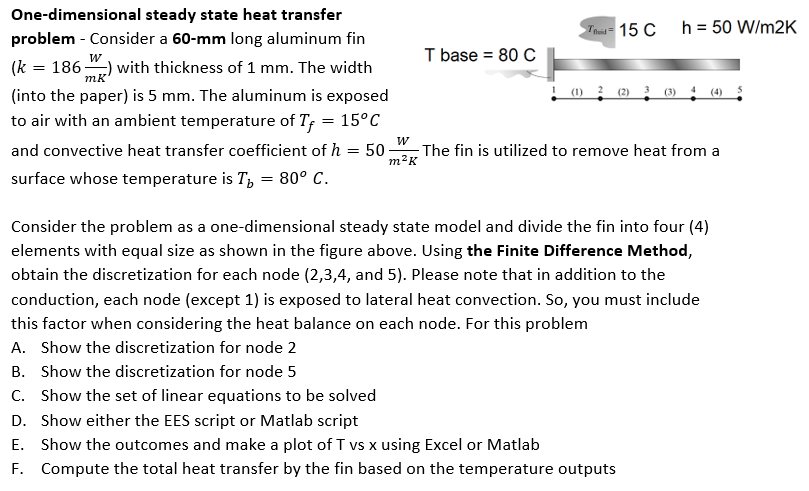One-dimensional steady state heat transfer problem - Consider a 60-mm long aluminum fin W mK (k = 186 ) with thickness of 1 mm. The width (into the paper) is 5 mm. The aluminum is exposed to air with an ambient temperature of Tf = 15°C and convective heat transfer coefficient of h = 50- surface whose temperature is T₁ = 80° C. W m²K T base = 80 C T15 C h = 50 W/m2K The fin is utilized to remove heat from a Consider the problem as a one-dimensional steady state model and divide the fin into four (4) elements with equal size as shown in the figure above. Using the Finite Difference Method, obtain the discretization for each node (2,3,4, and 5). Please note that in addition to the conduction, each node (except 1) is exposed to lateral heat convection. So, you must include this factor when considering the heat balance on each node. For this problem A. Show the discretization for node 2 B. Show the discretization for node 5 C. Show the set of linear equations to be solved D. Show either the EES script or Matlab script E. Show the outcomes and make a plot of T vs x using Excel or Matlab F. Compute the total heat transfer by the fin based on the temperature outputs
One-dimensional steady state heat transfer problem - Consider a 60-mm long aluminum fin W mK (k = 186 ) with thickness of 1 mm. The width (into the paper) is 5 mm. The aluminum is exposed to air with an ambient temperature of Tf = 15°C and convective heat transfer coefficient of h = 50- surface whose temperature is T₁ = 80° C. W m²K T base = 80 C T15 C h = 50 W/m2K The fin is utilized to remove heat from a Consider the problem as a one-dimensional steady state model and divide the fin into four (4) elements with equal size as shown in the figure above. Using the Finite Difference Method, obtain the discretization for each node (2,3,4, and 5). Please note that in addition to the conduction, each node (except 1) is exposed to lateral heat convection. So, you must include this factor when considering the heat balance on each node. For this problem A. Show the discretization for node 2 B. Show the discretization for node 5 C. Show the set of linear equations to be solved D. Show either the EES script or Matlab script E. Show the outcomes and make a plot of T vs x using Excel or Matlab F. Compute the total heat transfer by the fin based on the temperature outputs
Principles of Heat Transfer (Activate Learning with these NEW titles from Engineering!)
8th Edition
ISBN:9781305387102
Author:Kreith, Frank; Manglik, Raj M.
Publisher:Kreith, Frank; Manglik, Raj M.
Chapter2: Steady Heat Conduction
Section: Chapter Questions
Problem 2.30P: 2.30 An electrical heater capable of generating 10,000 W is to be designed. The heating element is...
Related questions
Question
100%

Transcribed Image Text:One-dimensional steady state heat transfer
problem - Consider a 60-mm long aluminum fin
mk
(k = 186) with thickness of 1 mm. The width
(into the paper) is 5 mm. The aluminum is exposed
to air with an ambient temperature of Tf = 15°C
and convective heat transfer coefficient of h = 50
surface whose temperature is T = 80° C.
W
m²K
T base = 80 C
Tid 15 C
(3)
h = 50 W/m2K
The fin is utilized to remove heat from a
C. Show the set of linear equations to be solved
D. Show either the EES script or Matlab script
E.
Show the outcomes and make a plot of T vs x using Excel or Matlab
F. Compute the total heat transfer by the fin based on the temperature outputs
Consider the problem as a one-dimensional steady state model and divide the fin into four (4)
elements with equal size as shown in the figure above. Using the Finite Difference Method,
obtain the discretization for each node (2,3,4, and 5). Please note that in addition to the
conduction, each node (except 1) is exposed to lateral heat convection. So, you must include
this factor when considering the heat balance on each node. For this problem
A. Show the discretization for node 2
B. Show the discretization for node 5
Expert Solution
This question has been solved!
Explore an expertly crafted, step-by-step solution for a thorough understanding of key concepts.
This is a popular solution!
Trending now
This is a popular solution!
Step by step
Solved in 4 steps with 8 images

Knowledge Booster
Learn more about
Need a deep-dive on the concept behind this application? Look no further. Learn more about this topic, mechanical-engineering and related others by exploring similar questions and additional content below.Recommended textbooks for you

Principles of Heat Transfer (Activate Learning wi…
Mechanical Engineering
ISBN:
9781305387102
Author:
Kreith, Frank; Manglik, Raj M.
Publisher:
Cengage Learning

Principles of Heat Transfer (Activate Learning wi…
Mechanical Engineering
ISBN:
9781305387102
Author:
Kreith, Frank; Manglik, Raj M.
Publisher:
Cengage Learning